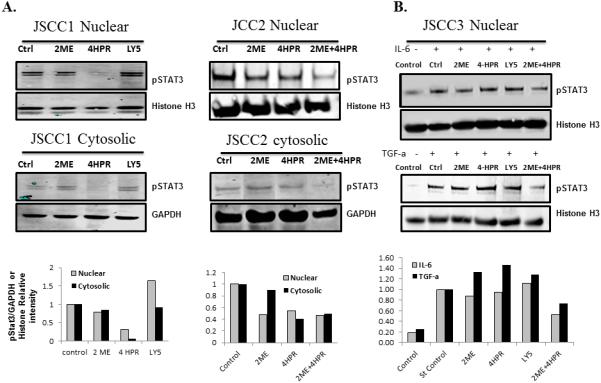Figure 2. Treatment effects of fenretinide (4-HPR, 5μM), 2-methoxyestradiol (2-ME, 2.5 μM) and the STAT3 inhibitor LY5 (0.5 μM) [30] on STAT3 phosphorylation and nuclear translocation.

Figure 2.A. (JSCC1 cells), B. (JSCC2 cells) and C. (JSCC3 cells). Cytosolic and nuclear proteins were harvested from sera deprived JSCC1 and JSCC2 cell lines following 24 h of treatment (5 μM 4-HPR, 2.5 μM 2-ME, or 0.5 μM LY5) or vehicle (0.1% DMSO) control. Multiple experiments confirmed 5 μM 4-HPR treatment significantly reduced constitutive STAT3 phosphorylation and pSTAT3 nuclear translocation in the STAT3 constitutively active JSCC1 and JSCC2 cells (p< 0.05, Wilcoxon matched pairs signed rank test, n=7). C. As the JSCC3 cells don't constitutively express pSTAT3, these cells underwent 24h stimulation in base medium supplemented with 10 ng/mL of IL-6 or 5 ng/mL of TGF-α, with or without 4-HPE, 2-ME or LY5 treatment, followed by harvest. The combination treatment of 2ME and 4-HPR significantly inhibited IL-6 or TGF-α induced pSTAT3 nuclear translocation in JSCC3 cells. (n=3, p<0.05, Wilcoxon matched pairs signed rank test). Figure 2.D. Effect of single and combination treatments of fenretinide (4-HPR, 5μM), 2-methoxyestradiol (2-ME, 2.5 μM) and the IL-6 receptor inhibitor TOC (1 ug/ml) on STAT3 and pSTAT3 levels. Figure D, E. All cell lines with constitutive pSTAT3 expression (2095sc, JSCC1 and JSCC2) were sera deprived for 24h, followed by an additional 24 hour of treatment in sera-free medium that contained: control (0.1% DMSO), 5μM 4-HPR, 2.5 μM 2-ME, 1 μg/ml TOC (initial agent concentrations same for single and combinations). As the JSCC3 cells don't constitutively express pSTAT3, these cells underwent 24h stimulation in base medium supplemented with10 ng/mL of IL-6 and 5 ng/mL of TGF-α, with or without 4-HPR, 2-ME and TOC followed by harvest. Selective treatments induced reduction of both STAT3 and pSTAT3 levels in2095sc cells, and to a lesser extent JSCC1 and JSCC3 cells. The treatment combinations of TOC + 4-HPR and TOC+4-HPR+2-ME induced significant inhibition of STAT3 phosphorylation [p<0.05, n=12 total with n=3 for every individual cell line (including JSCC3)], Kruskal Wallis followed by Dunn's Multiple Comparison post hoc test).
